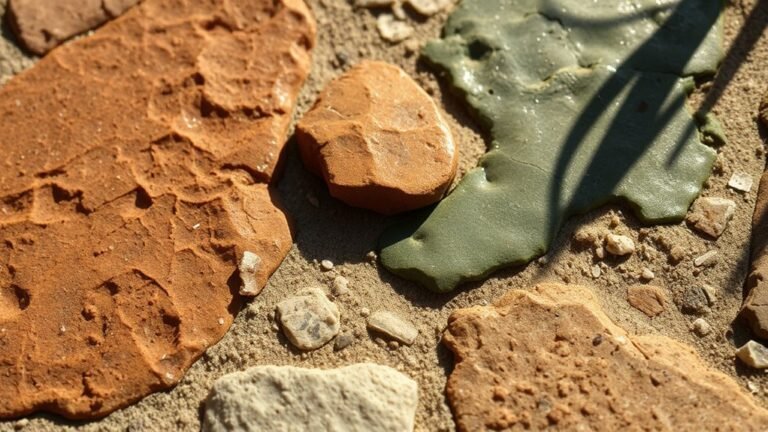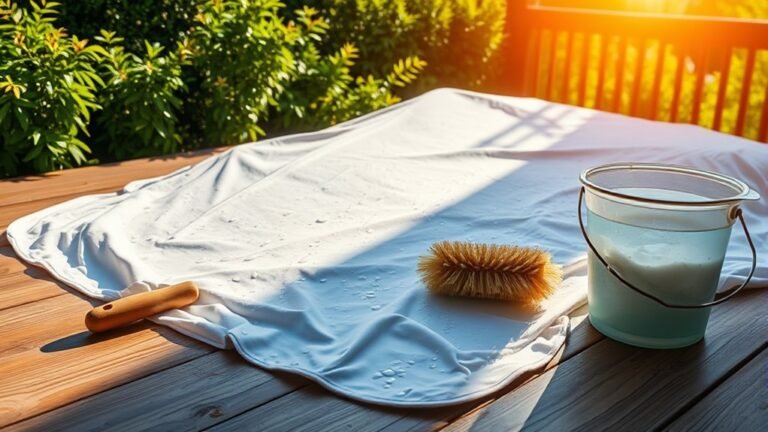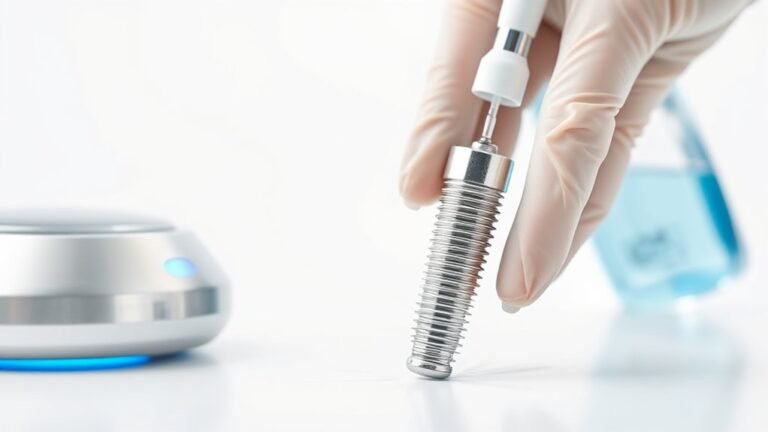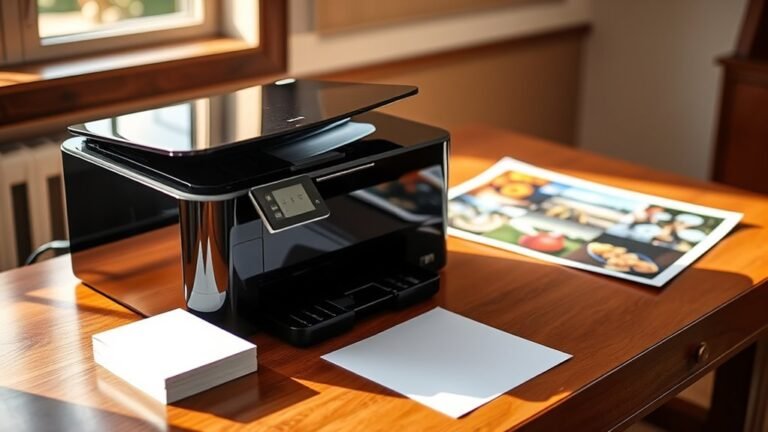How to Remove Adhesive Residue From Surfaces
To remove adhesive residue, start by identifying the adhesive type and clean the surface with warm, soapy water to soften the sticky film. If residue remains, gently rub in household oils like coconut or olive oil to break it down. For tougher spots, try rubbing alcohol or vinegar, but always test on a hidden area first to avoid damage. Using the right method prevents scratches and keeps surfaces safe—there’s more to learn about effective techniques for different materials.
Understanding Different Types of Adhesive Residue

Adhesive residue comes in various forms, each with its own properties and challenges. When you understand the types of adhesives, you gain the freedom to tackle sticky situations effectively. Some adhesives are water-based, like glue sticks, which are easier to remove, while others, like epoxy or super glue, have stronger adhesive properties that demand more care. Tape residues often leave behind a tacky film, while label adhesives can harden over time, making removal tougher. Knowing these differences empowers you to choose the right approach without damaging your surfaces. Don’t let adhesive residue limit your freedom—recognize the type you’re dealing with, and you’ll be better prepared to restore your space to its original state, hassle-free and confident.
Preparing the Surface for Adhesive Removal
Knowing the type of sticky residue you’re dealing with helps set the stage for effective removal. Before diving in, start with proper surface cleaning to guarantee no dirt or dust interferes with the process. Use a gentle cleaner and a soft cloth to wipe down the area, giving you a fresh canvas to work on. This step is vital for residue preparation, as leftover grime can make the adhesive harder to remove and potentially damage your surface. Once clean, dry the area completely to avoid any moisture mixing with cleaning agents later. Taking these simple steps frees you to tackle adhesive residue confidently, making certain your surface stays intact and ready for the next removal method. Preparing well always leads to smoother, more efficient results.
Using Warm Soapy Water to Loosen Residue

One of the easiest ways to start loosening sticky residue is by using warm soapy water. Mix a gentle soapy solution with warm water, then apply it to the affected area using a cloth or sponge. The warmth helps soften the adhesive, while the soapy solution breaks down its grip on the surface. Let it sit for a few minutes to penetrate the residue. Afterward, gently rub the area in circular motions to lift the adhesive without damaging the surface. This method gives you control and freedom to tackle sticky messes without harsh chemicals. If needed, reapply the warm soapy solution and repeat until the residue loosens enough for easy removal. This simple approach is effective, safe, and puts you in charge of restoring your surfaces.
Applying Household Oils to Break Down Stickiness
Although warm soapy water is effective, household oils can offer a quicker way to break down sticky residue. You have several oil types at your disposal, like olive oil, coconut oil, or even baby oil, each working well to loosen adhesive without harsh chemicals. Here’s how you can apply them:
- Dab a small amount of your chosen oil onto a clean cloth or cotton ball.
- Gently rub the sticky area in circular motions, allowing the oil to penetrate and soften the residue.
- Let it sit for 5–10 minutes before wiping away with a fresh cloth.
These application methods give you freedom to tackle sticky messes easily while protecting your surfaces. Just pick an oil type that suits your preference and enjoy a smooth cleanup!
Using Rubbing Alcohol or Vinegar for Effective Cleaning
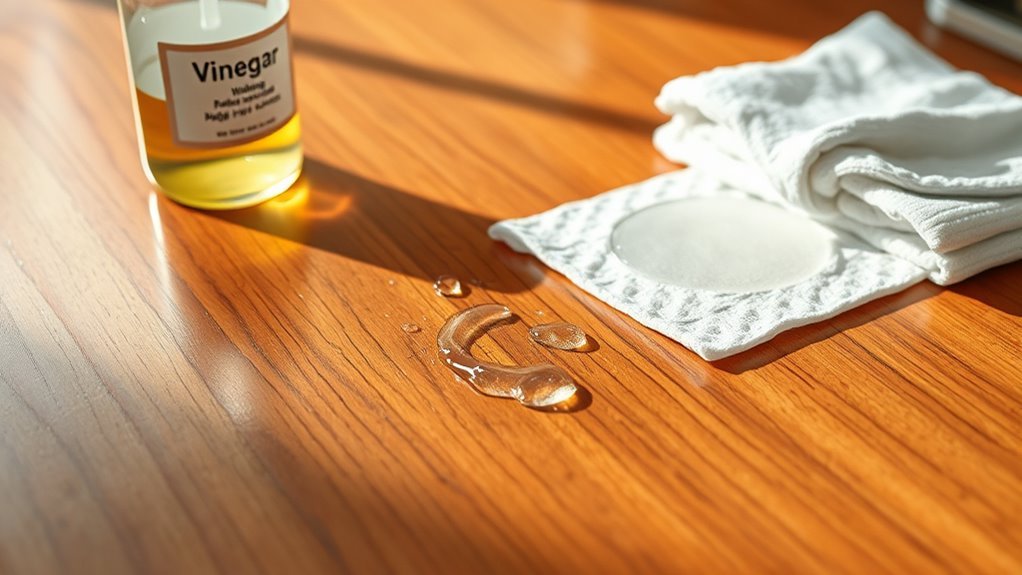
When it comes to tackling adhesive residue, you can choose between rubbing alcohol or vinegar depending on the surface and stubbornness of the glue. Both work well, but rubbing alcohol tends to be stronger, while vinegar is gentler and natural. To get the best results, apply your choice with a cloth, let it sit briefly, then gently rub away the residue.
Choosing Between Alcohol and Vinegar
Before deciding whether to use rubbing alcohol or vinegar to remove adhesive residue, you’ll want to contemplate the type of surface and the stubbornness of the residue. Both options have their perks, but choosing the right one can save you time and protect your surfaces.
- Alcohol advantages: It evaporates quickly, works well on plastic and glass, and breaks down sticky substances effectively without leaving a strong smell.
- Vinegar benefits: It’s natural, less harsh, great for wood and fabric, and also deodorizes while loosening residue.
- Consider the surface sensitivity and residue toughness—alcohol suits tougher, non-porous surfaces, while vinegar is gentler for delicate or porous materials.
Application Tips for Residue Removal
Since both rubbing alcohol and vinegar can be effective for removing adhesive residue, knowing how to apply them properly will make your cleaning easier and more efficient. Start by testing a small, hidden area to avoid damage. Use a clean cloth or cotton ball soaked in your chosen solution and gently dab the residue—don’t pour directly onto surfaces. Let it sit briefly to loosen the adhesive without drying out. One of the best practices is to apply consistent, gentle pressure while wiping away the residue, avoiding scrubbing that can scratch or damage surfaces. Common mistakes include overusing the liquid, which can cause staining or warping, and rushing the process. By following these tips, you’ll confidently remove sticky messes and enjoy a cleaner space with freedom from stubborn adhesives.
Utilizing Commercial Adhesive Removers Safely
Although commercial adhesive removers can be very effective, you’ll need to handle them with care to avoid damaging surfaces or harming yourself. These commercial products often contain strong chemicals, so following safety precautions is crucial to maintain your freedom to work confidently and safely.
- Always wear gloves and work in a well-ventilated area to protect your skin and lungs from harsh fumes.
- Test the remover on a small, hidden spot first to verify it won’t discolor or damage the surface.
- Follow the manufacturer’s instructions precisely, avoiding prolonged contact or excessive amounts.
Removing Residue From Delicate Surfaces
When dealing with adhesive residue on delicate surfaces, you’ll want to use gentle cleaning methods to avoid damage. Choosing safe solvents like rubbing alcohol or mild soap can help loosen the residue without harming the material. Always test a small area first to make sure the surface stays intact.
Gentle Cleaning Methods
If you need to remove adhesive residue from delicate surfaces, you’ll want to approach the task with care to avoid damage. Using gentle scrubbing techniques combined with natural cleaning solutions guarantees you protect the surface while freeing it from sticky residue. Here’s how you can do it:
- Dampen a soft cloth with a mild natural solution, like diluted white vinegar or a gentle soap mix.
- Gently rub the area in small, circular motions, avoiding harsh pressure that might scratch or wear down the surface.
- Rinse with a clean, damp cloth and dry immediately to prevent moisture damage.
These gentle cleaning methods let you reclaim your space without risking harm, keeping delicate surfaces intact and residue-free.
Safe Solvent Options
Because delicate surfaces can easily be damaged by harsh chemicals, you’ll want to choose safe solvents that effectively remove adhesive residue without causing harm. Prioritize solvent safety by selecting options labeled non-toxic and gentle on materials like wood, glass, or painted finishes. Eco friendly options such as white vinegar, rubbing alcohol diluted with water, or citrus-based cleaners provide effective cleaning power while respecting both your surfaces and the environment. Always test any solvent in an inconspicuous area first to verify it won’t cause discoloration or damage. By choosing these safer, eco friendly solvents, you maintain your freedom to clean without worry, protecting delicate surfaces while reducing your ecological footprint. This approach lets you remove residue efficiently and responsibly, keeping your space pristine and sustainable.
Preventing Surface Damage
Choosing safe solvents is just the first step in protecting your surfaces from damage. When dealing with delicate materials, you need to prioritize surface protection to maintain their integrity. Here’s how you can prevent harm while removing adhesive residue:
- Test first: Always try your solvent or adhesive alternative on a hidden spot to make certain it won’t discolor or weaken the surface.
- Use gentle tools: Opt for soft cloths or plastic scrapers instead of metal ones to avoid scratches.
- Consider adhesive alternatives: For future projects, choose tapes or glues designed for easy removal to minimize residue and damage.
Tips to Prevent Adhesive Residue in the Future
While it’s easy to focus on removing adhesive residue after the fact, taking a few simple precautions can save you time and effort down the road. First, consider the adhesive types you’re working with; some leave less residue than others. Opt for removable or low-tack adhesives when possible, especially on delicate surfaces. Always check surface compatibility before applying any adhesive—this helps prevent stubborn residue and surface damage. You can also use painter’s tape or protective films as a barrier to avoid direct contact. When removing adhesive, do it slowly and at the right temperature to minimize leftover residue. By understanding your adhesives and surfaces, you gain the freedom to stick and unstick without the hassle of cleaning up sticky messes later.
Frequently Asked Questions
Can Adhesive Residue Cause Damage to Electronic Devices?
Yes, adhesive residue can cause adhesive damage to your electronic devices, especially if it seeps into openings or covers vents, leading to overheating or malfunction. You’ll want to prioritize electronic safety by carefully removing any sticky remains without using harsh chemicals that might harm sensitive components. Taking this cautious approach lets you maintain your device’s freedom to perform well without risking damage from leftover adhesives.
How Long Should Adhesive Remover Sit Before Wiping Off?
Imagine you’ve just spilled glue on your favorite notebook. For best product effectiveness, you’ll want to let the adhesive remover sit for about 5 to 10 minutes after application. This timing allows it to break down the residue without damaging the surface. Don’t rush—giving the remover enough time means you can wipe away the mess smoothly, freeing you from sticky struggles and keeping your space clean and hassle-free.
Are There Natural Alternatives to Commercial Adhesive Removers?
You sure can skip commercial removers if you prefer natural options. Try a vinegar solution—it’s simple, effective, and eco-friendly. Just mix equal parts vinegar and water, apply it to the residue, and let it sit a bit before wiping away. Another great choice is citrus oil; its natural solvents break down adhesive without harsh chemicals. These alternatives give you freedom from toxins while still getting the job done cleanly and safely.
Can Adhesive Residue Be Removed From Fabric Without Washing?
Back in the days of the Wild West, quick thinking was key—and you can apply that here. When you want to remove adhesive residue from fabric without washing, you’ve got to use fabric safe solutions like rubbing alcohol or a gentle adhesive remover. Dab carefully and avoid rubbing harshly to protect your freedom to wear what you want. These adhesive removal techniques help you reclaim your clothes without a full wash, keeping your style intact.
What Should I Do if Adhesive Remover Irritates My Skin?
If adhesive remover causes skin irritation, stop using it immediately to avoid more discomfort. Rinse the affected area thoroughly with cool water and mild soap to soothe your skin. For safe handling next time, always wear gloves and work in a well-ventilated space to protect yourself. If irritation persists or worsens, consider consulting a healthcare professional. Protecting your skin means you can confidently tackle tasks without worrying about harm.

